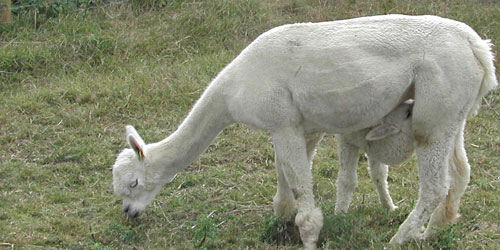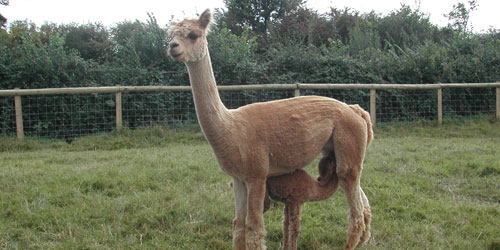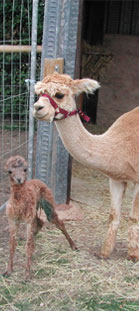Birthing
If you choose to breed alpacas you will obviously need to be aware of the various signs of labour and how to cope with a normal birth. We will offer all the help and advice we can, and are more than willing to share our own experiences and those we have gained from others. Below is a brief description of how a 'normal' birth should proceed but if at all worried or in any doubt you should seek veterinary assistance.
Before we bought our first alpacas we consulted our veterinary surgeon for some advice relating to general husbandry as well as birthing. We were told that as a general rule alpacas encounter few problems when giving birth other than perhaps a misplaced limb that can be corrected relatively easily. However there are no guarantees which is why it is important to keep a close watch over your females in the weeks prior to their due date. Regular checks are crucial to insure that all progresses well. 
Alpacas tend to give birth in the morning generally before lunchtime. This is unlike the majority of traditional British farm animals who frequently keep their owners up all night!!
Labour usual proceeds fairly rapidly; sometimes with little warning! The mother may isolate herself from the herd or may just behave in an unusual manner. Some animals will roll frequently and most will keep returning to the dung pile. All or our alpaca mothers make a humming noise similar to what may be heard when they are unsure of something.
A correct presentation starts with the appearance of the nose and the two front legs. Once the head has appeared the cria may then dangle for a short period which allows fluid to drain from the lungs. The shoulders which are the largest and most difficult to deliver then follow. Birth is fairly imminent as the rest of the body and hind legs fall to the ground.
Human intervention at this stage should be minimal to allow mother and baby to bond. However it is important to spray the umbilical cord with an antiseptic spray as this is an easy path for infection to enter the newly born animal. It is critical that a cria receives colostrum from its mother within at least the first 3-4 hours. Therefore it is recommended that you keep a close eye on both mother and baby for at least the first 24 hours to ensure that feeding is well established. If the cria does not feed within 6 hours of birth it is advisable to give a colostrum replacer. 
The placenta (afterbirth) is usually passed within a few hours of delivery.
| 
